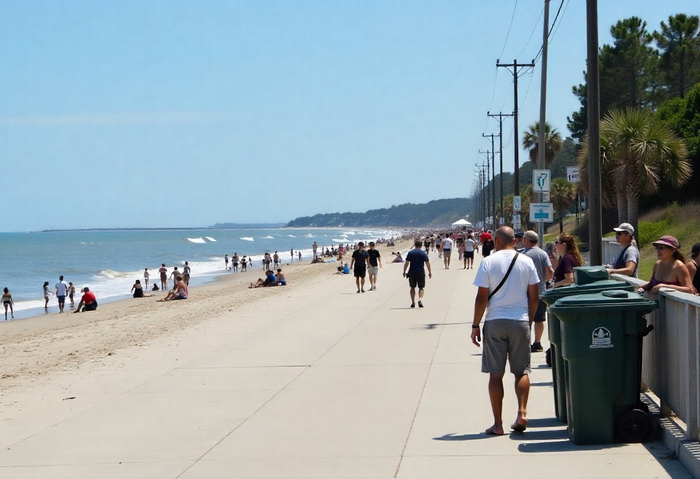Published on
November 16, 2025

South Carolina joins North Carolina, Florida, and Virginia in grappling with an escalating overtourism crisis that is reshaping some of America’s most popular coastal destinations. Once celebrated for expansive beaches, scenic landscapes, and peaceful community life, these regions are now under intense pressure from relentless visitor growth. Seasonal peaks, driven by both domestic and international travelers, have led to overcrowded attractions, traffic congestion, and soaring demand for accommodations, straining infrastructure and public services such as emergency response, waste management, and transportation. Residents increasingly experience the daily impact, from rising living costs to long waits and the visible wear on natural environments, underscoring the urgent need for balanced strategies that protect communities while supporting tourism economies.
America’s famed beach towns, once seen as serene escapes, are facing unprecedented challenges as massive crowds and rapid development test the limits of their charm and capacity. What were once quiet retreats have transformed into high-pressure destinations, where congested streets, packed beaches, and aging infrastructure dominate daily life. These coastal paradises now confront the difficult question of sustainability, as communities are forced to manage the delicate balance between welcoming visitors and preserving the very character that made them iconic.
Key West, Florida: A Tropical Icon Feeling the Strain
At the southern edge of the country, Key West faces a tourism reality defined by sharp contrasts. While the island remains one of Florida’s premium draws, its small geographic footprint creates enormous pressure during high-volume months. Visitor numbers fluctuate, but demand for parking, beach access, and mobility far exceeds what the island’s narrow streets can support.
Congestion from cars, bikes, scooters, and rental transports creates a near-constant clash on roads never intended for heavy tourism traffic. Accommodation rates across major Florida cities—Miami, Tampa, and Key West included—remain high, while rising food prices and premium charges at high-traffic venues make vacations more costly than ever. Families searching for value increasingly struggle to justify the expense.
Virginia Beach, Virginia: A Tourism Powerhouse With Growing Pains
Millions of visitors return annually to this Atlantic favorite, reinforcing its status as a tourism powerhouse but also spotlighting deepening challenges. Summer seasons bring packed beaches, long waits at restaurants, and persistent congestion across the oceanfront district.
Some quieter beach pockets exist, but accessing them often requires navigating limited parking or crowded public spaces. This has created subtle tension between visitors seeking serenity and residents trying to protect their daily quality of life. In 2023, Virginia Beach recorded a tourism impact of USD 3.8 billion—a remarkable economic boost paired with rising stress on everyday infrastructure and environmental spaces.
Outer Banks, North Carolina: A Barrier-Island Haven Under Heavy Pressure
The celebrated barrier islands of North Carolina have become one of the East Coast’s most sought-after playgrounds. Visitor spending in the state has climbed into the billions, reflecting the region’s rise as a year-round destination. With popularity soaring, however, the challenges multiplying beneath the surface are impossible to ignore.
Roads that were built for small communities now struggle with relentless traffic. Seasonal surges overwhelm local services, and housing demand—driven partly by short-term rentals—continues to push up living costs. Even major natural attractions such as the Great Smoky Mountains experience crowding that diminishes the outdoor escape visitors seek. For residents, daily routines have become an obstacle course shaped by intense visitor volume.
Myrtle Beach, South Carolina: A Grand Strand Destination Under Seasonal Siege
Myrtle Beach, the crown jewel of South Carolina’s Grand Strand, faces one of the most intense seasonal population spikes in the region. Each summer, its modest year-round community transforms into a bustling tourism metropolis.
The result is a long-running battle with crowding, slow traffic, stretched emergency services, busy hospitals, and wait times at restaurants that can extend for hours. Neighborhoods near the beach experience soaring rental demand during peak seasons, while basic tasks—finding parking, grocery shopping, navigating main roads—become exhausting for locals. Even water and waste systems feel the burden of millions of temporary residents.
Panama City Beach, Florida, Emerald Coast Beauty: Facing Seasonal Growing Pains
Panama City Beach continues to ride Florida’s larger wave of record visitation, especially during spring break and summer holidays. Its turquoise shoreline and family-oriented attractions draw millions, but these surges put powerful strain on the region’s infrastructure.
Hotels fill months in advance, rental prices rise dramatically, and local residents frequently avoid core tourism areas altogether. Emergency services work at heightened intensity during peak periods, while beaches show increased erosion, litter, and environmental wear caused by constant foot traffic.
A National Overtourism Challenge
These destinations collectively reveal a national dilemma: overtourism. When visitor numbers exceed what a place can sustainably support, consequences emerge—overcrowded streets, exhausted local workers, stressed natural environments, and communities that feel increasingly displaced. While tourism fuels local economies, the trade-off is becoming more difficult to ignore.
America’s coastal escapes now face a defining question: how to protect their identity, environment, and livability while continuing to welcome the guests who keep their economies thriving. Balancing these priorities will determine whether these beach towns remain beloved destinations—or become cautionary tales of paradise under pressure.
South Carolina joins North Carolina, Florida, and Virginia in facing a high impact struggle with overtourism as massive visitor surges overwhelm beaches, congest streets, and push local services and infrastructure toward breaking point.
As South Carolina, North Carolina, Florida, and Virginia continue to grapple with the pressures of overtourism, the need for sustainable solutions becomes increasingly urgent. Coastal communities must find ways to balance economic benefits with the preservation of local quality of life, infrastructure, and natural environments. Without careful management, the very attractions that draw millions of visitors each year—pristine beaches, scenic landscapes, and vibrant communities—risk being diminished by overcrowding and overuse. The challenge is clear: these iconic destinations must adapt, implementing strategies that ensure tourism remains a source of prosperity rather than a force of strain, so that both residents and travelers can continue to enjoy the beauty and charm of America’s coastline for generations to come.



